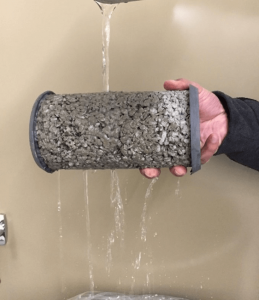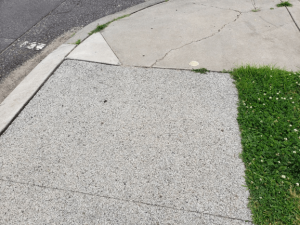While pervious (or porous) concrete has been gaining popularity as a potential solution to flooding, puddling, and to slowing storm-water runoff, there are still concerns about its ability to provide sufficient structural support, its longevity, as well as life cycle costs. As part of a pilot project funded by NJDOT and FHWA, Rutgers and CAIT-affiliated researchers, alongside Montgomery Township, are building a 1,500-square ft. test sidewalk made of porous concrete in Montgomery, NJ to collect performance data.

Porous concrete is considered a potential solution to reduce impermeable surface area associated with sidewalks. Photo ©Dr. Husam Najm.
A pilot project in Montgomery, New Jersey is helping Rutgers researchers collect important data on porous-concrete based sidewalks, their structural support, longevity, short-and long term performance, and how different mix designs behave out in the field.
To do so, a 1,500-square ft. test sidewalk will be constructed alongside the Skillman Road Pathway in Montgomery Township that is made of different porous concrete mixes that will be monitored over time. The results will help provide information to Montgomery Township, The New Jersey Department of Transportation (NJDOT), and the larger engineering community on porous concrete field performance, maintenance plans, construction practices, service life, and environmental benefits.
“Porous concrete has been gaining popularity as a potential solution to reduce the amount of impermeable surface area associated with sidewalks, reduce puddling, and potentially slow high flow rates from storm-water runoff, ” said Dr. Husam Najm. “As important as these benefits are to surface runoff mitigation, there are concerns with the ability of porous concrete mixes to provide sufficient structural support and longevity for the expected service life of the sidewalks.”
A professor in the Department of Civil and Environmental Engineering at Rutgers University, Director of the Undergraduate Program, and a CAIT-affiliated researcher; Dr. Najm has led the implementation project, which is funded by NJDOT and the U.S. Department of Transportation’s Federal Highway Administration.
He explained that the composition of porous concrete creates limitations to mechanical strength and maintenance challenges that can prevent it from achieving expected service life. In addition, the performance of porous concrete sidewalks is dependent on its geographical location, subsurface conditions, and intended application.
In January, the team began surveying possible implementation sites, before ultimately choosing the Skillman Road Pathway for the 1,500 square ft. test sidewalk location. Construction is expected to begin later this year.
“We will build a test sidewalk using three different mix designs of porous concrete,” Dr. Najm said. “The test sidewalk will include multiple sections that will be set up to evaluate the effects of construction and maintenance methods on field performance and life-cycle cost as well.”
He said the goal is to provide the Township and agencies with data that can help them make more informed and equitable decisions with porous-concrete sidewalks in terms of performance, service life, and environmental impacts moving forward.

Researchers will also be evaluating existing porous concrete sidewalks, such as this sample in Camden, NJ. Photo ©Dr. Husam Najm.
“Montgomery Township has been at the forefront of environmentally sensitive planning and using cutting-edge technology, and we are excited to partner with Rutgers on this exciting pilot project using porous concrete pavement,” said Gail Smith, PE and Township Engineer of Montgomery Township. “The Township has about 40 miles of recreational pathways and this new pathway will provide an important connection to a highly utilized County park. It will serve as an educational tool for our residents on the importance of storm-water management and impacts on flooding.”
In addition to building and testing the test sidewalk, researchers are also evaluating existing porous concrete sidewalks in New Jersey, and reporting on their conditions and performance.
Three sites were identified in Camden, NJ. Visual inspection and infiltration tests were performed on these sites, and 4 in x 8 in cores will be taken from the sidewalks to be tested at the Rutgers-CAIT Asphalt and Pavement Lab for strength, density, and voids.
“We look forward to learning a lot from these test sidewalks,” Dr. Najm said. “In the next phase of our research, we will take what we have learned to other parts of the state where we can perform visual inspection, infiltration tests, and take core samples all to better understand porous concrete and its applications.”

